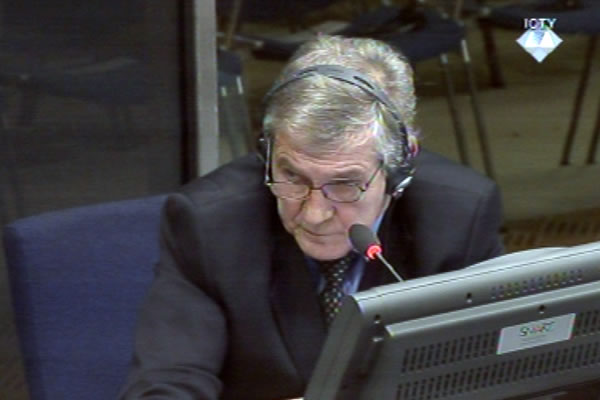Home
PRISONERS IN COWSHEDS
In his evidence in Karadzic’s defense, former security officer in the 1st Krajina Corps Radomir Radinkovic claimed that the highest standards of accommodation were in force in the Manjaca prison camp. This prompted the prosecution to show evidence that the prisoners slept on concrete floors where cows used to be kept. The prisoners were starved and abused in various ways, the prosecution argued
 Radomir Radinkovic, witness at the Radovan Karadzic trial
Radomir Radinkovic, witness at the Radovan Karadzic trial Former security officer in the 1st Krajina Corps Radomir Radinkovic was in charge of the Manjaca prison camp during the war in BH. From the spring to the end of 1992, thousands of prisoners were detained there. In the statement to Radovan Karadzic’s defense, the witness said that the prisoners of war enjoyed the highest standards of accommodation, food and health care in the prison camp. The military police that secured the area inside the prison camp treated the prisoners in line with the Geneva conventions, the witness stated.
At the very outset of the cross-examination, prosecutor Edgerton contested the allegations about all but perfect accommodation. She put it to the witness that the prisoners in the Manjaca prison camp were housed in several large stables, where they slept on concrete floors; cows used to be kept in those facilities. Radinkovic replied that the ‘facilities used to be stables’ but they were refurbished to accommodate people. Prisoners were given blankets and straw to sleep on. While the prosecutor insisted the buildings were nothing but stables, the witness was even more stubborn in his replies, saying that the hygienic conditions were fit for ‘people, not cows’.
A report of the International Red Cross dated 16 July 1992 stated that during their visit to the prison camp the general conditions they observed were ‘completely unsatisfactory’; many prisoners suffered anemia and weight loss as a consequence. Also, given that many witnesses testified that they were so starved during their stay in Manjaca that they ate grass and that they were given water from a lake where the guards urinated, the prosecutor concluded, the prisoners ‘were not only housed in the facilities meant for cows but were in fact treated like animals’. The witness replied that those were ‘arbitrary claims’ and assured the Trial Chamber that the prisoners were given the ‘best care that was available’.
The prosecution then put it to the witness that the people, some of whom were underage, elderly and ill, had been brought to Manjaca only because they weren’t Serbs. ‘I can state that they were not arrested because of their ethnic background but because they were suspected of being fighters or of working against the interests of Republika Srpska’, the witness replied. However, the witness agreed that 85 percent of the prisoners were Muslims, 15 per cent were Croats and only a couple of them were Serbs.
The indictment against Karadzic mentions two incidents related to Manjaca: death by asphyxiation of 24 men during the transport from Sanski Most on 7 July 1992 and the execution of prisoners from Omarska at the entrance to Manjaca in early August 1992. Radinkovic denied that the military police was responsible for the crimes because the crimes happened outside the perimeter of the prison facility and the perpetrators were ‘civilian police’. Judge Morrison asked the witness if a soldier watching the execution from a distance of about 20 to 30 meters had to react and prevent the crime, as a citizen. The witness said that was not the case, because the soldiers were in charge of the events ‘inside the perimeter and not in any way outside’ of the prison camp.
Highlighting Karadzic’s ability to exercise control over the events in Manjaca, the prosecutor recalled that in September 1992 Karadzic’s Presidency granted amnesty to 69 sick, underage and elderly prisoners. The proposal for their release landed on Karadzic’s desk through the chain of command, it was approved and then travelled back to Manjaca down the chain of command. ‘Exactly’, said Radinkovic.
After Radinkovic completed his evidence, Karadzic called Simo Miskovic. During the war, Miskovic was the president of the SDS municipal board in Prijedor. In his statement to the defense Miskovic said that Serbs seized power in that municipality on 30 April 1992 to ‘prevent the conflict’. The clashes did erupt, and were caused by the Muslim and Croat extremists. Miskovic claimed that his local board experienced difficulties in communicating with the leadership in Pale. This is why Miskovic had to make some decisions independently. Miskovic noted that he didn’t know about any plans to expel Muslims and Croats from Prijedor. Judging by the summary of the witness’s statement read out in the courtroom by the accused, in his interview with the defense team Miskovic didn’t mention the Prijedor prison camps: Keraterm, Omarska and Trnopolje. Miskovic, the last witness to give evidence this year, will complete his testimony Thursday.
Linked Reports
- Case : Karadzic
- 2013-12-17 STAKIC: CRIMES AND FORCIBLE EXPULSIONS OF PRIJEDOR INHABITANTS ARE A FACT
- 2013-12-17 TRIAL CHAMBER COMPELLED BEARA TO REPLY TO KARADZIC’S QUESTION
- 2013-12-17 KARADZIC WANTS ASSANGE
- 2013-12-19 PROFITEERING BEFORE MURDER
- 2014-01-09 KARADZIC’S PROOF OF ‘HOLBROOKE AGREEMENT’
- 2014-01-16 ‘STRONG’ EVIDENCE THAT SERBS ARE NOT RESPONSIBLE FOR MARKALE 2
